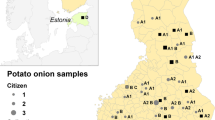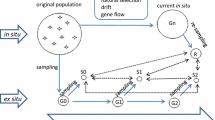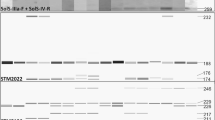Abstract
Potato onions (Allium cepa var aggregatum G. Don) are multiplying or aggregating onions, very similar to shallots and have been historically cultivated throughout Europe. Currently in Northern Europe they are maintained in home gardens and ex situ field collections. Potato onions are primarily vegetatively propagated, however in Estonia, near Lake Peipsi, this species has been propagated by seed since the seventeenth century. There is increasing interest in Northern Europe in utilizing this germplasm in organic and/or sustainable farming systems. The genetic diversity and relationship between and within European potato onion collections is unclear. From historical records it is known that cultivation, exchange and trade of potato onion has occurred throughout Europe for hundreds of years. This study utilised molecular markers to assess genetic diversity, duplication of genotypes and relationships among and between Nordic, Baltic, Czech and Croatian potato onion collections. Of 264 accessions, 80 catalogued as unique had identical genotypes with one or more other accessions, and are putative duplicates. The genetic diversity within two Estonian sexually propagated accessions was comparable to that found in all of the vegetatively propagated accessions. Accessions from the Nordic countries grouped together genetically, as did Latvian and Lithuanian accessions. Croatian accessions were genetically separated. These genetic relationships suggest historical movement of potato onion germplasm in North-Eastern Europe. The results, in conjunction with other passport and characterization data, can assist in the development of potato onion core collections, facilitating the conservation and utilization of valuable potato onion genetic resources.

Similar content being viewed by others
Data availability
Germplasm is available via respective genebanks, genotype data available upon request from corresponding author.
References
Bender I, Annamaa K, Michelson A, Põldma P, Rungis D (2019) Cultivation of potato onion (Allium cepa var. aggregatum) in Estonia. In: Programme and abstract book of the NJF conference on horticulture 2019, Tartu, 10–12 June 2019, p 22
De Vahl E (2020) Potato onion, Johannes onion or Nordic shallot?—historical growing systems, denomination and introduction for Allium cepa Aggregatum-Group. Master’s dissertation, Swedish University of Agricultural Sciences. https://doi.org/10.13140/RG.2.2.31869.31203
Fischer D, Bachmann K (2000) Onion microsatellites for germplasm analysis and their use in assessing intra- and interspecific relatedness within the subgenus Rhizirideum. Theor Appl Genet 101:153–164. https://doi.org/10.1007/s001220051464
Galpern P, Manseau M, Hettinga P et al (2012) Allelematch: an R package for identifying unique multilocus genotypes where genotyping error and missing data may be present. Mol Ecol Resour 12:771–778. https://doi.org/10.1111/j.1755-0998.2012.03137.x
Galluzzi G, Eyzaguirre P, Negri V (2010) Home gardens: neglected hotspots of agro-biodiversity and cultural diversity. Biodivers Conserv 19(13):3635–3654
Goudet J (1995) Computer note computer program to calculate F-statistics. J Hered 86:485–486
Hanelt P (1990) Taxonomy, evolution and history. In: Rabinowitch HD, Brewster JL (eds) Onions and allied crops, vol I. Botany, physiology and genetics, pp 1–26
Heinonen M (2014) Landrace in situ conservation strategy for Finland. MTT Report 163. https://urn.fi/URN:ISBN:978-952-487-570-7
Jombart T, Devillard S, Balloux F (2010) Discriminant analysis of principal components: a new method for the analysis of genetically structured populations
Kalia RK, Rai MK, Kalia S et al (2011) Microsatellite markers: an overview of the recent progress in plants. Euphytica 177:309–334. https://doi.org/10.1007/s10681-010-0286-9
Khosa JS, McCallum J, Dhatt AS, Macknight RC (2016) Enhancing onion breeding using molecular tools. Plant Breed 135:9–20. https://doi.org/10.1111/pbr.12330
Klaas M, Friesen N (2002) Molecular markers in Allium. In: Rabinowitch HD, Currah L (eds) Allium crop science: recent advances. CAB International, Wallingford, pp 159–185
Leino MW, Hagenblad J (2014) Potato onion: the missing link to onion cultivation in the past. Bull för trädgårdshistorisk Forsk 27:17–19
Leino MW, Solberg S, Tunset HM et al (2018) Patterns of exchange of multiplying onion (Allium cepa L. Aggregatum-Group) in Fennoscandian home gardens. Econ Bot 72:346–356. https://doi.org/10.1007/s12231-018-9426-2
Muthoni J, Shimelis H, Melis R (2019) Long-term conservation of potato genetic resources: methods and status of conservation. Aust J Crop Sci 13(5):717
Peakall R, Smouse PE (2006) GENALEX 6: genetic analysis in excel. Population genetic software for teaching and research. Mol Ecol Notes 6:288–295. https://doi.org/10.1111/j.1471-8286.2005.01155.x
Porebski S, Bailey LG, Baum BR (1997) Modification of a CTAB DNA extraction protocol for plants containing high polysaccharide and polyphenol components. Plant Mol Biol Report 15:8–15
Rungis DE, Voronova A, Kokina A et al (2017) Assessment of genetic diversity and relatedness in the Latvian potato genetic resources collection by DArT genotyping. Plant Genet Resour Charact Util 15:72–78. https://doi.org/10.1017/S1479262115000398
Strese EMK, Lundström M, Hagenblad J, Leino MW (2014) Genetic diversity in remnant swedish hop (Humulus lupulus L.) yards from the 15th to 18th century. Econ Bot 68(3):231–245
Taranovs V (1968) Dārzeņkopība Latvijā (Vegetable cultivation in Latvia). “Liesma”, Riga (in Latvian)
Wang MR, Zhang Z, Haugslien S, Sivertsen A, Rasmussen M, Wang QC, Blystad DR (2018) Cryopreservation of shallot (Allium cepa var. aggregatum) shoot tips by droplet-vitrification. In: III International symposium on plant cryopreservation 1234, pp 241–248
Wedelsbäck Bladh K, Liljeroth E, Poulsen G, Yndgaard F, Brantestam AK (2014) Genetic diversity in Nordic horseradish, Armoracia rusticana, as revealed by AFLP markers. Genet Resour Crop Evol 61(2):383–394
Westling M, Leino MW, Nilsen A et al (2019) Crop and livestock diversity cultivating gastronomic potential, illustrated by sensory profiles of landraces. J Food Sci 84:1162–1169. https://doi.org/10.1111/1750-3841.14582
Acknowledgements
Financial support was obtained through the European Cooperative Program for Plant Genetic Resources (ECPGR) activity Grant “SafeAlliDiv”. HS acknowledges the support of the Ministry of Agriculture of the Czech Republic, institutional support MZE-RO0418. IMV acknowledges support from Norwegian Agriculture Agency genetic resources grants. SGB acknowledges support of Ministry of Agriculture of Republic of Croatia and project KK.01.1.1.01.0005 ‘Biodiversity and Molecular Plant Breeding’.
Author information
Authors and Affiliations
Contributions
HS and LL developed the concept of the research. LL, SGB, EdV, KA, PP, TSA, DJ, IMV, HS provided plant material and morphological data. DR performed the genotyping and prepared the draft manuscript with input from CK and MWL. All authors provided critical feedback and helped shape the research, analysis and manuscript. HS coordinated and supervised the research.
Corresponding author
Ethics declarations
Conflict of interest
Not applicable. The authors do not declare any financial or other conflicts. Funding sources are given above.
Ethics approval
Not applicable. Research subjects were not human or animal.
Human and animal rights
Not applicable. Research subjects were not human or animal.
Informed consent
All authors have participated in preparation of the manuscript and consent to submit the manuscript for peer review.
Code availability
Not applicable. No software or other code was developed as part of this research.
Additional information
Publisher's Note
Springer Nature remains neutral with regard to jurisdictional claims in published maps and institutional affiliations.
Electronic supplementary material
Below is the link to the electronic supplementary material.
Rights and permissions
About this article
Cite this article
Ruņǵis, D., Leino, M.W., Lepse, L. et al. Genetic characterization of European potato onion (Allium cepa var Aggregatum G. Don) collections. Genet Resour Crop Evol 68, 657–665 (2021). https://doi.org/10.1007/s10722-020-01014-2
Received:
Accepted:
Published:
Issue Date:
DOI: https://doi.org/10.1007/s10722-020-01014-2




